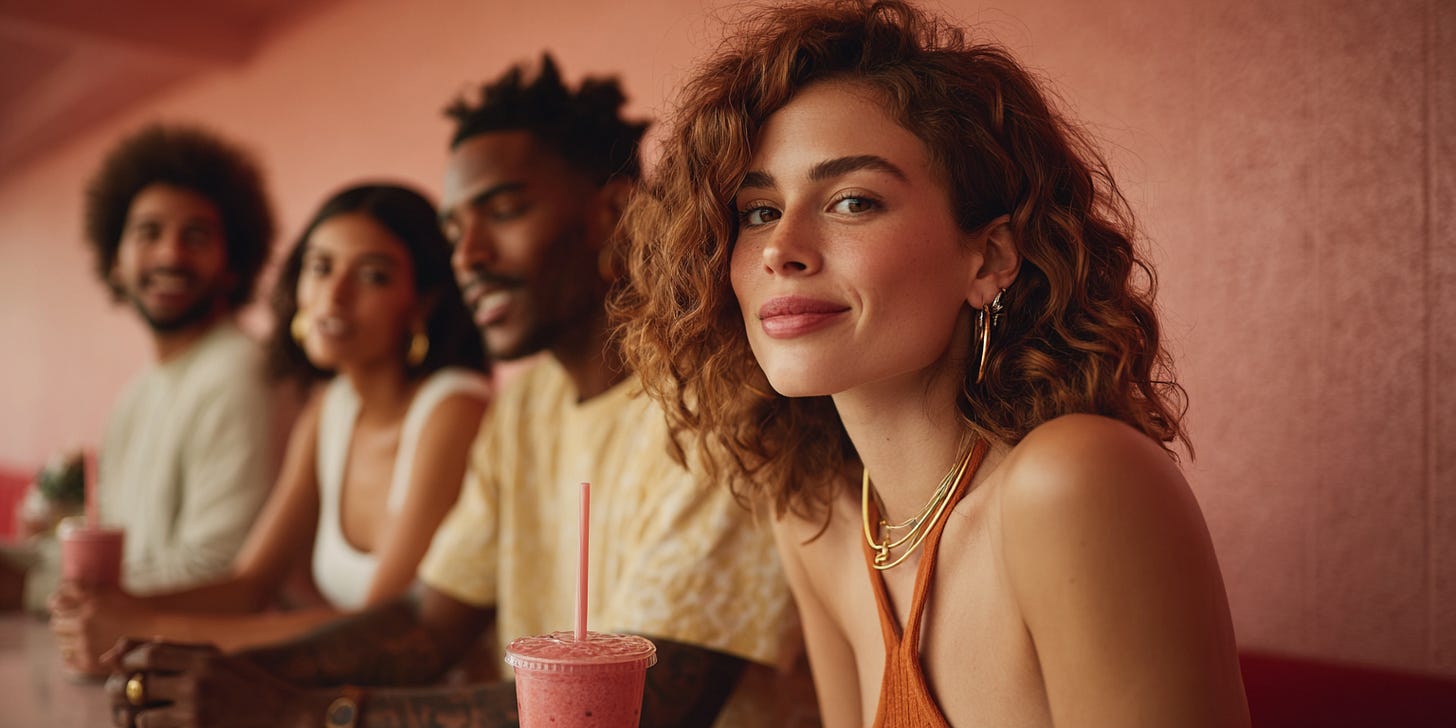Function Becomes Flavour: From Indulgence to Enhancement
The next era of Food & Beverage isn’t about taste — it’s about transformation.
In Brief
Taste used to be the reward.
Now, it’s the vehicle.
Food and beverage are evolving from hedonistic pleasures to performance tools — from indulgence to enhancement. Consumers are no longer asking “Does it taste good?” They’re asking “What does it do for me?”
Caffeine meets collagen. Chocolate meets cognition. Beverages promise better moods, sharper minds, calmer guts.
Welcome to the Function Economy — where the pantry becomes the pharmacy, and the bar becomes the lab.
The brands that will dominate the next decade won’t just flavour your tongue; they’ll rewire your day.
Category & Context
The food industry is standing at the same cultural crossroads once faced by tech: from entertainment to infrastructure. What began as “better-for-you” is now “built-for-you.” The $300B functional foods sector is forecast to double by 2030. And the battleground is no longer supermarkets — it’s states of being: calm, focus, energy, sleep, immunity, glow.
When Coca-Cola buys a collagen brand and PepsiCo launches mood drinks, you know something fundamental has shifted.
We’re no longer just feeding hunger — we’re feeding identity.
Signal — What’s Happening
Functional takes mainstream: Functional beverages are growing 3x faster than total soft drinks; energy and mood drinks lead.
Cognitive nutrition boom: Nootropics, adaptogens, and brain-friendly beverages like Kin Euphorics, Recess, and Magic Mind redefine the “morning ritual.”
Beauty ingestibles explode: The line between skincare and food blurs — collagen waters, hyaluronic teas, and “beauty gummies” go mass.
Mood-based food: Calm chocolate, focus snacks, relaxation beverages dominate next-gen wellness retail.
Longevity lifestyle: Aging becomes a performance metric; nutrition brands shift from youth to cellular resilience.
Pharma-casual culture: Supplements and snacks merge — the “pharmafication” of pantry and fridge.
Relevance — Why It Matters
The post-pandemic consumer has one obsession: control.
Health is no longer a medical concept; it’s an operating system. People aren’t trying to live forever — they’re trying to live better now. And they expect brands to help engineer that improvement.
For F&B companies, this means the end of the “treat” era. A product that delivers pleasure alone now competes against products that deliver benefit.
Energy, focus, recovery, immunity — once niche — are now mass behaviour triggers.
The stakes are commercial, not just cultural. Functional positioning increases brand loyalty, raises price tolerance, and extends consumption frequency.
In other words: function = margin.
Insight — What It Means
We’ve entered the era of edible performance.
People no longer buy calories; they buy capabilities.
Every snack, drink, and supplement competes for a role in the personal operating system of self-optimization.
The rise of Function is not about health — it’s about agency.
When life feels chaotic, people seek micro-control: one can, one bar, one shot that promises stability.
This changes the role of brand from entertainer to enabler.
It’s not about “escape” anymore. It’s about enhancement.
The old F&B model: seduce the senses.
The new model: upgrade the system.
And when everything becomes functional, the defining competitive edge will be trust — not taste.
Shift — What’s Changing
Opportunities — Where to Build Advantage
1. Function Becomes the New Premium
Consumers will pay more for what they can feel.
Create benefit-led hierarchies: from basic wellness (hydration, digestion) to elite performance (focus, recovery, longevity).
Premium is now measured in outcomes, not origin stories.
2. Cross the Category Lines
Snacks, supplements, beverages, and beauty are merging into one giant functional ecosystem.
If you’re a drink, you’re a supplement. If you’re a bar, you’re a ritual.
Innovation will come from category trespass.
3. Build Proof-Based Brands
The next marketing revolution isn’t storytelling — it’s science-telling.
Lab results, data dashboards, biofeedback partnerships — proof becomes packaging.
Brands that can quantify their claims will win both consumers and credibility.
Plays — How to Execute Now
1. Strategy & Brand
Define your human function. What do you make happen in someone’s life — not what you make. Are you focus? Calm? Resilience? Beauty?
Build a benefit architecture. Map your brand portfolio by functional state rather than flavour.
Own an emotion. Energy and calm are overcrowded; emerging white spaces: confidence, creativity, clarity.
Be science-forward, not sterile. Translate lab legitimacy into lifestyle aspiration — science you can sip.
Adopt the “systems brand” mindset. Think Apple for the body: interconnected products, unified purpose.
2. Marketing & Communications
Ditch the health preach. Function should feel cool, not clinical. Sell empowerment, not avoidance.
Create rituals, not consumption moments. Morning focus shot. Post-lunch reboot. 9pm wind-down. Design habits, not ads.
Make data sexy. Use transparency dashboards, live biomarker results, or co-branded testing partners as engagement content.
Educate through experience. Pop-up tastings + on-site biometric tracking = proof in public.
Partner with performance tribes. From yoga collectives to esports teams — anywhere optimization is social.
3. Product & Service Innovation
Invent new ingestion formats. Gels, dissolving strips, chewables, mood waters — the form is the differentiator.
Merge functionality. Combine sensory pleasure (flavour, fizz, texture) with functional payloads (adaptogens, probiotics, botanicals).
Use biofeedback loops. Pair products with apps that track mood or energy. Turn consumption into a closed system of self-knowledge.
Design stackable systems. Create product families meant to work together: morning, midday, night.
Expand into “performance snacking.” Replace mindless munching with intentional fueling.
4. Design & Experience
Signal science through simplicity. Visual restraint = credibility. Think precision, not chaos.
Make function feel sensual. Use tactile textures, sound cues, and colour psychology to evoke effect (calm = muted tones, energy = saturation).
Label the benefit, not just the flavour. “Calm + Coconut” > “Coconut Water.”
Design for continuity. Packaging and experience should make each product feel like part of a system — a suite, not a SKU.
Create experiential proof points. Pop-up labs, sensory installations, smell and sound pairings.
5. Culture & Operations
Hire hybrid thinkers. Nutrition scientists + storytellers. Chemists + brand designers.
Align incentives with proof. Reward teams for measurable functional outcomes, not vanity metrics.
Build cross-discipline R&D pods. Food tech, behavioural science, and creative design in the same room.
Sourcing as story. Trace every ingredient to its purpose. “Why it’s there” is part of your marketing.
Institutionalise curiosity. Run internal “bio-trend sprints” every quarter — constant discovery keeps you leading, not reacting.
The Bottom Line
The most powerful brands in the next decade won’t just taste good — they’ll make people better.
“Delicious” is no longer enough.
You need to be useful.
The brands that win in this space will master one idea:
Food and beverage are no longer categories.
They’re interfaces for human potential.
---
P.S Like getting more trends like this to your inbox?
Original Minds Intelligence offers not only access to hundreds of trends, consumer insights, actionable ideas across multiple industries, categories, and disciplines - we also provide a Brand Pulse for monitoring your brand space and giving you brand-specific insights and actions.
For inquiries, EMAIL US
.




